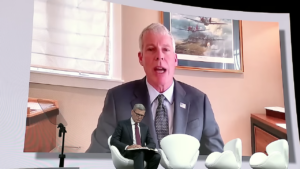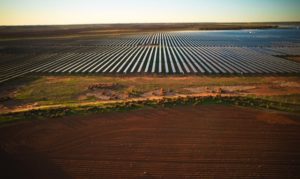Oz Minerals is one of the biggest mining companies in Australia, and it is now developing one of the most ambitious off-grid renewable energy projects in the world – how to power a $1 billion mining project with 100 per cent renewables.
It’s a remarkable development when you think about it. For years, the loudest opponent of climate action and renewable energy support has been the mining lobby, particularly through the Minerals Council of Australia.
But while the key players of the MCA campaign now find themselves ensconced within prime minister Scott Morrison’s inner advisory circle, fighting the same fight as though nothing has changed, much of the mining industry itself has moved on, embracing the new technologies pathetically lampooned by the PM.
BHP has already committed to 100 per cent renewables at its massive Chile operations – helped by that country’s extraordinary solar resources and its hydro plants – and has torn up a long term coal contract (at great cost) to deliver it. BHP and other big iron ore miners like Rio Tinto and Fortescue are also looking for renewables to dominate their power supply in the Pilbara and elsewhere.
Oz Minerals wants to go one step further. It is planning a $1 billion nickel and copper project in remote country, 500km west of Uluru and near the intersection of the South Australia, West Australia and Northern Territory borders. It has already drawn up a strategy to power those operations with up to 80 per cent wind and solar, supported by battery storage and some fossil fuel generation.
But it wants to get to 100 per cent renewables. And it’s looking for new ideas on how to do that. The key, it believes, is learning what to do with “spilled energy” and it suspects that demand management – devising software that ensure its energy demand coincides with high wind and solar output – is a key. However, saying that is one thing, doing that is another.
Oz Minerals put a call out this week for individuals, teams and organisations who could assist it in reaching its target of 100% renewable energy usage at the West Musgrave project. “Early-stage and novel concepts are encouraged, as are commercially ready solutions,” it says.
The biggest challenge is not in producing enough wind and solar, it is delivering it in a way that can match the demand curve of an operating mine, or by making the demand curve flexible enough to match the output.
“Currently, the West Musgrave Project is looking at a high penetration renewable solution to provide power for its mining and processing operations, supported by a fossil fuel fired power station,” the company says. “This includes wind and solar generation assets and a battery energy storage system. The current design has enabled renewable energy to meet 70 – 80% of total demand.”
 Luke Sandery, the company’s “Package Manager” responsible for the power needs at West Musgrave and other projects, says those calculations are based on the assumed average load of around 40MW, peaks of up to 55MW and plans for about 180MW of wind and solar, split around two thirds wind and one third solar.
Luke Sandery, the company’s “Package Manager” responsible for the power needs at West Musgrave and other projects, says those calculations are based on the assumed average load of around 40MW, peaks of up to 55MW and plans for about 180MW of wind and solar, split around two thirds wind and one third solar.
That means that most of the time, the available renewable energy is expected to exceed demand. If all this can be captured, say by battery storage, it should be sufficient to cover the remaining operating hours.
But Oz Minerals says at current costs, that is not economically viable to capture all of that spilling, which means around 25 per cent of the output is effectively lost, referred to as “spilled energy”. (See graph above assumed summer wind output is in blue, and peaks at night, and solar PV is in orange, and storage in dotted line).
That means that non-renewable generation such as expensive and polluting diesel power units are needed to meet the remaining 20 – 30% demand.
“We have already paid for these (wind and solar) assets, so this energy is effectively free!” the company’s document says. “Under the base based, no value given to spilled energy in current model” which currently amounts to around 60 gigawatt hours a year.
Oz Minerals has been looking at several different options to reduce the need for fossil fuels, or basically move the spilled energy) in green in graph above), to the black (where fossil fuel is used).
One strategy is demand management – and looking at ways to create flexible, variable demand (the bulk of it which comes from ore handling and ore processing) that would align with renewable generation profiles, and another is different forms of battery energy storage systems. Another is electrifying the mining fleet.
“The primary focus of this challenge is the identification of renewable energy solutions that can be incorporated into the plans for the West Musgrave project,”
“Secondary to this goal, OZ Minerals is searching for novel and innovative renewable energy solutions that may have broader business applications across OZ Minerals operations, can be incorporated into future projects and may play a role in assisting OZ Minerals to transition to achieve net-zero emissions by 2050.”
Indeed, Sandery says that while the company has an official goal of getting to net zero emissions by 2050, it has other “internal aspirations that push us further than that.”
Pleaese note: Oz Minerals is not a member of the MCA.











